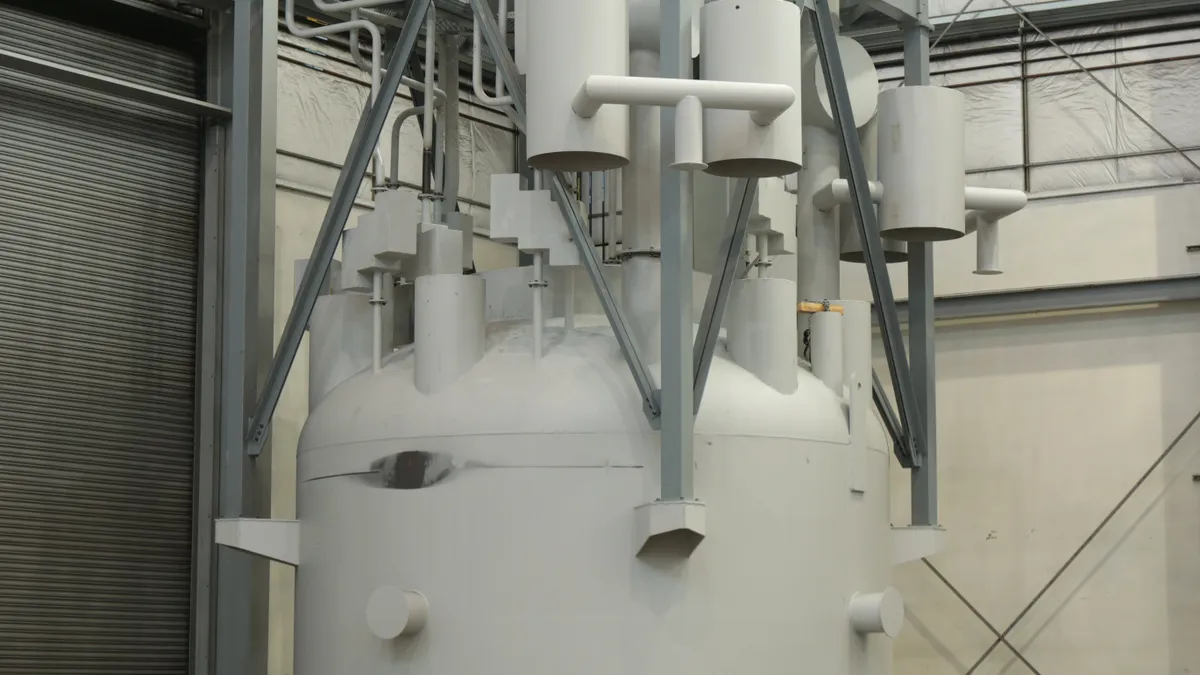Dive Brief:
-
The Nuclear Regulatory Commission has completed the first phase in the design certification application (DCA) process for NuScale Power’s small modular reactor (SMR).
-
There are another five phases in the design certification process, but NuScale says the first phase is the most rigorous and now expects the NRC to complete the certification process by September 2020.
- NuScale also said the Department of Energy’s Office of Nuclear Energy has awarded the company $40 million in cost-sharing financial assistance under a federal grant program that supports early stage research and development to promote U.S. energy independence, grid resiliency, national security and clean baseload power.
Dive Insight:
SMRs provide one of the small rays of hope for nuclear energy in the wake of the abandonment of V.C. Summer nuclear project in South Carolina by South Carolina Electric & Gas and Santee Cooper.
Summer, along with the Vogtle nuclear project under construction in Georgia by Southern Co. and its partners, were the first nuclear projects to break ground in about 30 years. But they were bedeviled by the some of the same problems that plagued previous nuclear projects: missed deadlines and cost overruns.
In contrast, SMR technology holds the potential for lower capital costs because modular components and factory production can potentially reduce construction costs and time. Proponents also cite the simplicity of design of SMRs, their enhanced safety features, and their flexibility in terms of siting, sizing, and end-use applications.
NuScale says that because of the simple design of its reactors, the NRC issued far fewer requests for additional information compared to other design certification applications.
NuScale’s design simplifies the safety measures required to avoid a meltdown, using a passive design that relies on a natural flow of water. SMRs also do not have to rely on the grid for power to run controls. That lessens the regulatory burden, as well as operating costs.
The NRC has engaged in varying degrees of pre-application activities with several designers of light water reactor SMRs over the past several years, but has received a design certification application from only NuScale. The NRC’s criterion for “small” is 300 MW or less.
Another contender in the light water SMR space is a partnership of Holtec International and GE Hitachi Nuclear Energy that has applied to the NRC for a pre-application certification for their SMR-160 SMR.
The Nuclear Energy Institute counts 12 companies engaged in developing SMRs, the trade group said during a media roundtable on the technology last month.
Overall, however, SMRs face a “challenging” environment, Dean Murphy a principal at The Brattle Group told Utility Dive via email. Wholesale power prices, fueled by cheap natural gas, are very low in most of the U.S., meaning “the bar for any nuclear project is a high one."
But if SMRs’ costs can be driven down by assembly-line-style manufacturing, they could have shorter lead times than a conventional nuclear project, reducing uncertainty as to whether the project will be needed by the time it is complete. Their smaller size would also make SMRs easier to finance and “not such a bet-the-farm proposition for whoever is footing the bill," Murphy wrote.
Cost estimates vary due to the variety of technologies in development, but nuclear experts put the cost of a SMR like NuScale’s in the ballpark of $2,500/kW, more than twice the cost of a new gas-fired project.
Because of their smaller size, SMRs are “probably losing some economies of scale,” Nuclear Energy Institute spokesman Matthew Wald told Utility Dive, but they stand to gain some operational advantages over larger nuclear plants.
The modular design of SMRs better enables the builders to size projects to match demand. And SMRs are being designed to operate flexibly, which would make them more valuable and adaptable on a grid with rising levels of intermittent resources such as wind and solar power.
For now, NuScale appears to be leading the SMR field. The company is working with Utah Associated Municipal Power Systems (UAMPS) for its first SMR project, a 12-module plant in Idaho slated for operation by the mid-2020s. NuScale and its partners would need to secure a combined operating and construction license from the NRC for the project.
The timeline for approval of that 600 MW project is June of 2023, Jackie Coombs, a spokesperson for UAMPS told Utility Dive via email. The SMR plant is expected to cost $4.2 billion to build and will be financed with low-cost, short-term bank loans that can be refinanced with long-term tax-exempt municipal bonds at the completion of the development and the commencement of construction, Coombs said.














